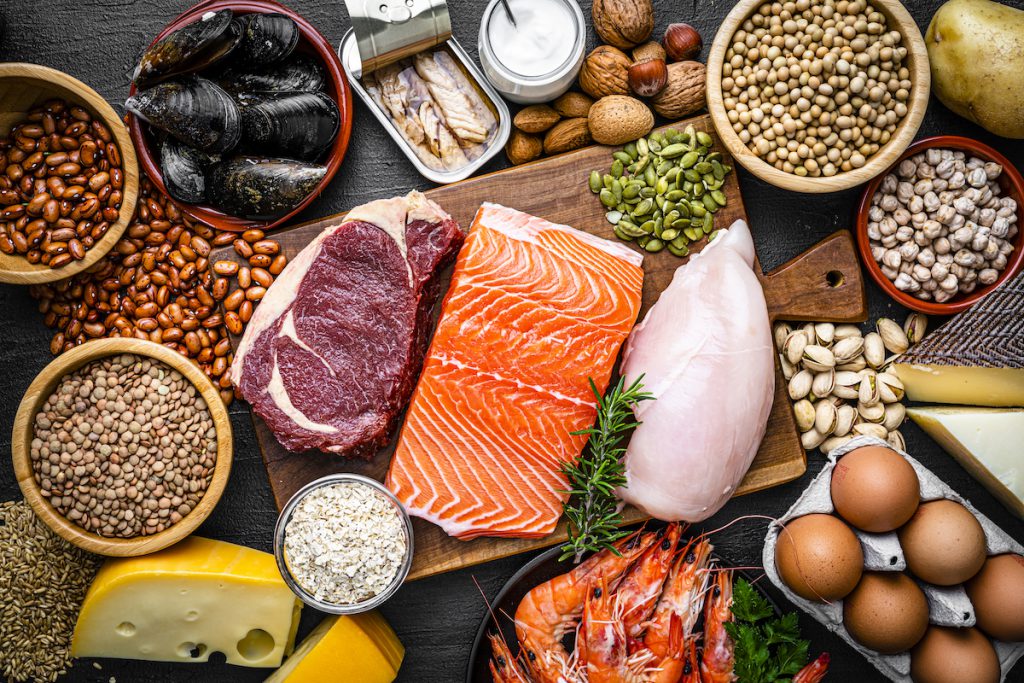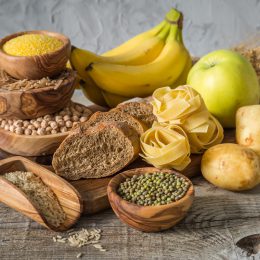How Much Protein Should You Eat Each Day?
The short answer: Probably more than you’re eating right now. Here’s why, plus how to meet your daily needs.

If nutrition were a popularity contest, protein would win running away—and for good reason. Not only does this macronutrient help you feel fuller longer, it’s also crucial to every cell in your body. You need it to build and maintain your bones, muscles, skin, and more.
Protein is even more important as you age, says Sonya Angelone, R.D.N., a spokesperson for the Academy of Nutrition and Dietetics. That’s because as you get older, you don’t absorb or metabolize amino acids—the building blocks of protein—as well as you did when you were younger, she explains.
Another reason to prioritize protein: “You lose muscle mass with age, and that’s associated with a higher risk of falls and, as a result, fractures,” says Mike Roussell, Ph.D., author of The Six Pillars of Nutrition. “When you optimize your protein intake, you are better able to maintain your lean body mass, which then reduces your risk of falls.”
Healthy eating and fitness go together! SilverSneakers classes and events are happening daily at participating gyms, online through SilverSneakers LIVE, and at community centers near you. Activate your free online account to get started.
How Much Protein Should You Eat Daily?
According to the National Academy of Medicine, the recommended dietary allowance (RDA) for adults in their 50s and older is 0.8 grams of protein per kilogram of bodyweight.
For an adult who weighs 130 pounds, that’s about 47 grams of protein per day. For one who weighs 150 pounds, 54 grams. And for one who weighs 170 pounds, 61 grams. To see your RDA for protein, multiply your weight in pounds by 0.36, or use this online calculator.
Roughly 50% of women and 30% of men older than 71 fall short of the RDA for protein in their diets, according to the USDA’s Dietary Guidelines for Americans, 2020-2025.
Skimping on protein isn’t a good idea. A 2018 study on older adults found that those who have higher protein intakes face lower odds of frailty and are 30% less likely to lose function integrity (a marker of things like grip strength and gait speed) compared to those who eat less protein.
But here’s where things can get confusing: The RDA is the minimum amount of a nutrient you need to meet your basic nutritional requirements, says Brady Hurst, clinical director for True Health Center for Functional Medicine in Atlanta.
For older adults, the RDA doesn’t seem to be enough to prevent muscle atrophy and frailty, according to a 2020 review in the journal Nutrients. Those findings are supported by a 2023 review of emerging research on protein needs for older adults published in the Journals of Gerontology.
In other words, if your goals are merely to live and not get sick, the RDA might be enough—you won’t be deficient in protein. This does not mean it’s optimal.
What’s the Optimal Amount of Protein?
The exact amount of protein you need for optimal health is debatable, as it depends on your weight, activity level, and any health conditions you have.
That said, many experts believe that to maintain muscle mass and proper functioning, older adults need to eat significantly more protein than they needed in their younger years, says Abby Sauer, M.P.H., R.D., a dietitian specializing in adult and geriatric nutrition.
In one American Journal of Physiology—Endocrinology and Metabolism study, adults ages 52 to 75 improved their muscle health by following a diet containing 1.5 grams of protein per kilogram of bodyweight per day. That’s roughly twice the current RDA.
Other guidance calls for a more modest increase. The National Resource Center on Nutrition and Aging recommends older adults consume 1 to 1.2 grams of protein per kilogram of body weight.
How to Increase Your Protein Intake
If those higher amounts seem like a lofty goal, take it one meal at a time, says Angelone. Aim to eat 25 to 30 grams of protein at breakfast, lunch, and dinner. These protein-packed breakfasts and high-protein dinners can help.
“For maximum tissue growth and repair, it’s really best to space out your protein evenly throughout the day,” Angelone says.
What Are the Best Sources of Protein?
More protein doesn’t necessarily mean more burgers, sausages, and steaks. The overall nutritional quality of a food matters.
Angelone recommends limiting red meat, which can be high in saturated fat, and instead building each meal around high-quality proteins like:
- Fish
- Lean poultry
- Dairy
- Eggs
- Legumes, such as beans, lentils, and chickpeas
“These foods are good protein sources and provide many other nutrients for good health,” Angelone says.
It’s good to vary your protein sources from meal to meal, day to day. In a 2022 study published in the journal Hypertension, eating different food sources of protein was associated with a reduced risk of high blood pressure. Among older adults, seafood, dairy, fortified soy milk, and legumes are all under consumed sources of protein, according to the USDA’s current Dietary Guidelines for Americans.
Another interesting finding: A team of international researchers looked at the effect of both protein quantity and source as it relates to muscle loss. They found that older adults who increased the amount of protein they got from plant-based sources were less likely to develop sarcopenia, compared to those who got more of their protein from animal sources. The 2020 study was published in the journal Nutrients.
Subscribe to our newsletter
It's quick and easy. You could be one of the 13 million people who are eligible.
Already a member? Click to discover our 15,000+ participating locations.
Follow Us
Recommended reading: Top 5 Plant-Based Sources of Protein for Older Adults
Will Protein Powders Help?
Meeting your protein needs from whole foods is best, but protein powders can be good for some.
The popular powders have been shown to help boost muscle strength in older adults with sarcopenia, according to a 2022 meta-analysis of randomized controlled trials published in the Archives of Gerontology and Geriatrics.
However, 2020 meta-analysis found that protein supplementation didn’t increase muscle mass, strength, or functioning in older adults who were not frail.
An Important Reminder
Guidelines are just that: guidelines. “They’re a good place to start,” Angelone says.
If you have a hard time meeting your daily protein requirement, ask your doctor or a registered dietitian for guidance. They can help you with meal planning or may recommend complete nutrition supplements.
See our sources:
Protein intake and functional integrity: Journals of Gerontology
Protein intake and muscle integrity: Journals of Gerontology
Protein needs for older adults: The National Resource Center on Nutrition and Aging
Dietary Guidelines for Americans, 2020-2025
Benefits of plant-based protein sources and sarcopenia: Nutrients
Benefits of varying protein sources for blood pressure: Hypertension
Effects of protein supplements in those with sarcopenia: Archives of Gerontology and Geriatrics
Effect of protein supplements on functional frailty: Archives of Gerontology and Geriatrics
Check Your SilverSneakers Eligibility Instantly
SilverSneakers members can go to thousands of nationwide gyms and fitness locations, plus take SilverSneakers LIVE online classes that are designed for all fitness levels and abilities. If you have a Medicare Advantage plan, it may include SilverSneakers — at no additional cost. Check your eligibility instantly here.
Already a member? Get your SilverSneakers member ID and exclusive fitness and wellness content by activating your online account here.
Not eligible for SilverSneakers? You can still get 200+ free SilverSneakers On-Demand videos and stay in touch with us by creating your online account.





